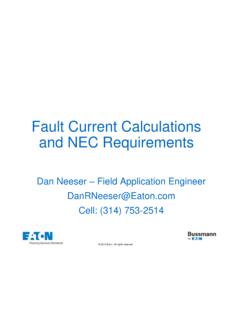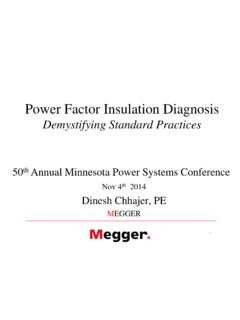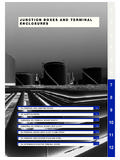Transcription of Applying the National Electrical Code to Substations
1 Applying the National Electrical code to Substations Jeff Heinemann Ulteig Mark Scheid Ulteig 3350 38th Ave. S. Fargo, ND. & Abstract: A discussion of the National Electrical code (NEC) and National Electrical Safety code (NESC) design considerations as applied to utility Substations , including working clearances, cable tray, cables, conduit, conduit fill, and station services in Electrical equipment enclosures. Through the guidance of the National Electrical code (NEC), we can meet the need for safe low-voltage designs by Applying the NEC in Substations whenever possible and practical. This paper will primarily focus on low-voltage, single phase designs (600V or less).
2 In order to apply the NEC to substation design, we must first and foremost educate ourselves and understand the intent of the NEC and then decide how it can be utilized in what we are doing. The NEC and NESC contain many applications for safeguarding personnel and equipment. The topics in these publications are so broad that it would be difficult or even next to impossible to discuss in their entirety. There are many topics such as grounding and bonding, warning signs, illumination, PT and CT. secondary grounding requirements, etc. that this paper will not address. This paper will discuss a few specific applications of the NEC while referencing the use of the more prevalent NESC and IEEE.
3 Documents in utility applications. The purpose of the NEC is the practical safeguarding of persons and property from hazards arising from the use of electricity (Section ). Refer to Section of the NEC for a listing of which installations are covered and those that are not. The purpose of the NESC is the practical safeguarding of persons, utility facilities, and affected property during the installation, operation, or maintenance of electric supply and communication facilities, under specified conditions. (Section 1, Rule 010). Refer to Section 1, Rule 011 for a listing of which installations are covered and those that are not.
4 In terms of the electric utility industry, the NEC does not cover installations in utility substation Electrical equipment enclosures (sometimes referred to as control buildings) and is not usually subject to Electrical inspections. Design considerations of the NEC, specifically low-voltage applications, are defined more completely in the NEC than in the NESC. In other words, the NESC provides criteria for what is to be executed, but not how it is to be accomplished, whereas the NEC defines both a standard for and methods of implementation. Although design within a utility substation falls under the jurisdiction of the NESC, the NESC does not specifically cover utilization wiring like the NEC does.
5 It is our interpretation as consulting engineers that the NEC should therefore be applied as a best practice in some specific applications within the Electrical equipment enclosure. Examples of these applications are: AC station service design, wiring methods and practices, and installation and selection of cables and raceways. The general contractor and consulting engineer are subject to the provisions of the NEC if the client specifies that the design and installation should adhere as such. Failure to comply with the rules could result in an installation that does not sufficiently protect personnel and/or equipment.
6 Ask yourself what it means to you when your specification includes verbiage for the design engineer and/or vendor to apply the NEC. We see this in many specifications, including our own. What does this mean if the NEC. doesn't apply in utility substation installations? The NESC covers a myriad of design rules for utility designs of high-voltage applications, whereas the NEC primarily covers low-voltage installations and utilization wiring. This paper will convey that there are specific areas within a utility substation that fall within the categorized code rules of the NEC where the NEC may be more stringent than those of the NESC.
7 This is a presentation of the use of these rules in concert, as well as from the standpoint of an Electrical inspector who may know and apply the NEC in the inspection rather than the rules of the NESC. Figure 1: Scope of NEC and NESC. Electrical Equipment Enclosure Working Space Working space (600V or less) around Electrical equipment is covered in Article 110, Section II of the NEC and Rule 125 of the NESC. Both codes require that sufficient access and working space is to be provided and maintained around all Electrical equipment to permit ready and safe operation and maintenance of such equipment. This paper highlights some of the similarities between the two codes but there are additional restrictive rules and requirements of the NEC.
8 Both codes require the same width and depth to a working space as identified in Tables (A)(1) and 125-1 of the NEC and NESC, respectively. The height of a working space is where the codes begin to be different. The NEC requires a working space height of 6'-6 from the floor/finished grade or to the height of the equipment, whichever is higher. The NESC simply states that the height is to be no less than 7'0 . The NEC goes on to further detail dedicated space above Electrical equipment, recommending no equipment that is not associated with the Electrical installation be installed in this space. As simple and straightforward as the dedicated equipment space may be, this is one of those common sense applications where a design engineer should give consideration.
9 As an example, the design engineer should avoid placing equipment that is not part of the Electrical system in the dedicated equipment space, as it causes safety and maintenance issues. If the foreign equipment were to require maintenance, a situation arises in which personnel are working directly over Electrical components which could possibly present a safety hazard. Additionally, the intent of the NEC is to prevent any leaks from the foreign equipment to enter the Electrical system from above. There are a few exceptions to the rule, such as installation of fire suppression systems. If it is simply unavoidable to install equipment above Electrical components, the NEC provides guidance to the design engineer on how to mitigate the hazard.
10 We feel that this additional component (dedicated equipment space) of the NEC is important too;. although the NESC does not require dedicated equipment space, it does make sense to account for it. Battery Rooms Almost every substation Electrical enclosure contains a battery bank(s). Some battery banks are housed within separate battery rooms adjacent to the main enclosure, whereas some are placed in the common area of the Electrical equipment enclosure. Depending on the type of battery, it is well known that hydrogen gas can be release when batteries are charging, and it is also well known that hydrogen gas can be highly explosive in concentrated amounts.






